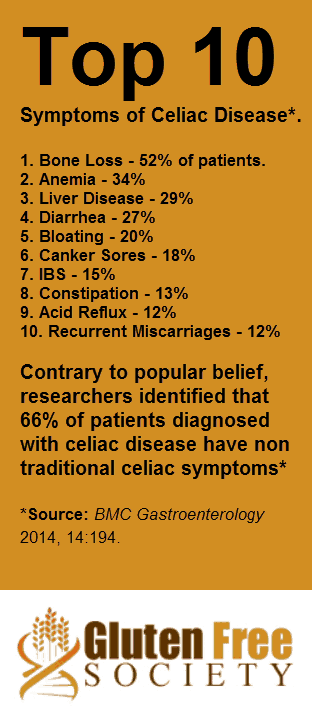The Most Common Symptoms of Celiac Disease
Celiac disease is an autoimmune disease that leads to an inflammatory destruction of the small intestines. The inflammation and intestinal damage is caused by exposure to gluten proteins found in grains and grain based foods like bread, pasta, pizza, bagels, baked goods, and more. It is estimated that 1-3% of the US population has this condition. Though the terms are also used interchangeably,t is important to note that celiac disease and gluten sensitivity are not the same thing. In essence, everyone with celiac disease is gluten sensitive, however; those with gluten sensitivity don’t always develop celiac disease, but instead develop
other health issues and autoimmune conditions.
This video breaks down the topic in detail. The symptoms of celiac disease can be very different than the symptoms of gluten sensitivity (AKA – Non Celiac Gluten Sensitivity or NCGA). Below is a breakdown of the symptoms commonly linked to celiac disease:
Celiac Symptoms That Your Doctor Will Look for

Typically, if a patient presents with chronic diarrhea, weight loss, intestinal pain, and/or iron deficiency anemia, doctors will run tests to try and rule out the presence of celiac disease. These tests typically include:
- A small intestine scope with biopsy
- Blood Tests for – anti tissue transglutaminase, anti-gliadin, and anti-endomysial antibodies
- And on rare occasion – Genetic Testing of the HLA-DQ genes to look for celiac markers
A 2014 research study found additional symptoms linked to celiac disease. The results were quite surprising, because they varied greatly from the traditional symptoms listed above. Two thirds of the patients in this study did not have classical symptoms of celiac disease. Some of the most common intestinal symptoms were:
Even more common, were extraintestinal symptoms (symptoms not related to the GI tract). These included:
This is not the only research study on the varying presentations of celiac disease and non celiac gluten sensitivity, it is just one of many that have confirmed that their is a huge variability in the way patients are affected by gluten.
Source:
Umberto Volta, Giacomo Caio, Vincenzo, Stanghellini, and Roberto De Giorgio. The changing clinical profile of celiac disease: a 15-year experience (1998-2012) in an Italian referral center.
BMC Gastroenterology 2014, 14:194
Why Are These Studies So Important?
The average person with celiac disease will go undiagnosed for up to 20 years. Partly because doctors are trained to look only for the traditional symptoms, and partly because the lab tests typically used for diagnosis are known to give frequent
false negative results. This lack of early diagnosis leads to years of inflammatory damage, severe malnutrition, increased risk for life threatening intestinal cancer, and a host of other health problems. Because the symptoms vary so greatly, many of these patients get misdiagnosed and placed on inappropriate medications for years before getting an accurate diagnosis. Much of this could be prevented with earlier detection. The key to earlier detection is education of both patients and doctors. The following graphic was designed to share with your doctor. If you have the symptoms on the list, and suspect that you may be gluten sensitive (celiac or non celiac), print the info graphic image out and take it to your physician. The research studies are also referenced on this graphic so that your doctor might take you more seriously and run the appropriate tests to help you identify gluten sensitivity (genetic testing).

 Typically, if a patient presents with chronic diarrhea, weight loss, intestinal pain, and/or iron deficiency anemia, doctors will run tests to try and rule out the presence of celiac disease. These tests typically include:
Typically, if a patient presents with chronic diarrhea, weight loss, intestinal pain, and/or iron deficiency anemia, doctors will run tests to try and rule out the presence of celiac disease. These tests typically include:

12 Responses
Thank you for this. . Education of medics and patients is vital! I was diagnosed with coeliac disease last year after years of illness and auto immune problems. . I have been been taking prescribed immune suppressive medication since 2000..! It looks like I was misdiagnosed, As a result of inappropriate meds I have lost my hip to a vascular necrosis, have squamous cell skin cancers and osteoporosis. But following the strict gluten free diet, together with FODMAPS and lactose free diets I am much improved.
one must be on a Gluten diet before the blood test for at least a month.
Do any other Celiacs have polymyalgia rheumatica?
Is there a link between high cholesterol manufactured by the body and the celiac gene markers?
No, but my great aunt was diagnosed with PR last March. She likely hasn’t been tested for coeliac or NCGS as these sorts of things appear to be unknown in the British National Health Service. However, I did some research & sent over a summary in printout. Unclear how many recommendations she might be following/not following, but I’ve heard that she is doing well! Hopefully that means they may have followed some of the advice?
While this list of celiac disease symptoms are composed by research scientists and verified by indisputable tests, how helpful is it to patients who are seeking a diagnosis of symptoms they really feel? Not very. More commonly experienced symptoms of celiac disease than those above include irritability, anxiety, depression, being sick and tired of being sick and tired, insomnia, muscle pain and stiffness especially back pain, and what can be variously described as lack of focus, being spaced out, or absent minded. I’m sure there are more that did not readily come to mind. Also, these symptoms occur in childhood as well as adulthood.
Yes indeed, so true. But also rashes,chronic cough,chronic pain,headache,and frequent viral illness. Now that I’m gluten free and feel better,my body continues to grow increasingly sensitive to any contamination,and I continue to develop new allergies. However,I’m still undiagnosed. I’ve had to take control of my own life, and not yield to doctors who are unable to get this. Educating the public saves at least a few of us from a lot of grief. My chronic pain decreased by about 80% when I stopped eating gluten and a few other foods.
Thanks for this report. It will be very beneficial to my patients.
You are welcome Doc!
Here is another link you can print out and share in your office – https://env-gfsociety-staging.kinsta.cloud/wp-content/uploads/2016/12/gluten-quiz-finished.pdf
What about pancreatitis and chronic pancreatitis cause by celiac, dumping syndrome, reactive hypoglycaemia, dizziness, hypotension, dry eyes my list goes on, as well as colic, backache, muscle aches, twitching, cramping, numbness, tentonitis, bone spurs, bone pain, joint pain, bad migraines, nausea, basal cells and excessive tiredness after food !
don’t forget about the neurological symtoms. I thought I was having a stroke, one of many symptons I have experienced.
Just stop eating gluten, grains and dairy and just see for yourself how things improve. Read Dr Osbornes book No Grain No Pain and educate yourself. Also his Gluten free society site online is a mine of information. Its all about research, self education, and taking responsibility for yourself.
In top 10 symptoms, none of the neurological symptoms have been listed, whereasy in >30% persons suffering from silent Celiac Disease, some neurological problems are bound to occur due to loss of Iron, B12, Calcium, Sodium, Magnesium, etc.